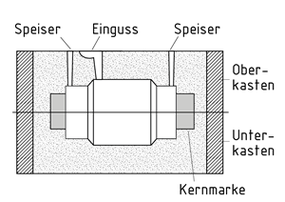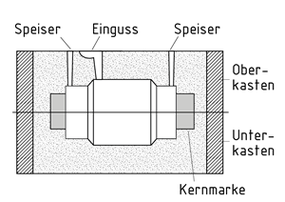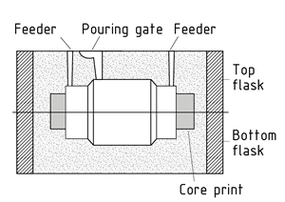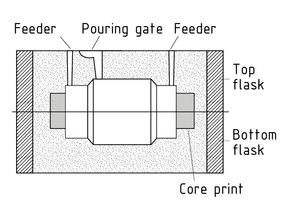
Seleccione uno
o más idiomas
0,1,3
- Alemán
- Inglés
- Chino
- Español
Fundición

La fundición es un proceso de conformado que se usa para producir productos primarios e intermedios (productos semiterminados), que pueden ser procesados posteriormente mediante la conformado. Se debe distinguir entre la fundición en un molde permanente y un molde reemplazable.
Los materiales de fundición son usualmente compuestos de hierro-carbono (hierro fundido, acero), metales no ferrosos como el cobre, el plomo y el níquel, metales ligeros como el aluminio y el magnesio, o aleaciones. También se pueden fundir otros materiales (por ejemplo, plásticos y yeso).
Los procesos incluyen, por ejemplo, la fundición de lingotes en moldes permanentes y la fundición continua.
Las propiedades de la fundición son determinadas por la composición de la fundición y la estructura de la fundición, en combinación con la tasa de enfriamiento, la nucleación y el crecimiento de cristal.
Una vez que el material fundido se vierte en el molde, la solidificación puede ser de pared recta, de pared áspera y tipo esponja (solidificación exógena) o formadora de coraza (endógena). El volumen de la fundición se reduce durante este proceso. Se agregan alimentadores para compensar.
Fundición de molde reemplazable
Gießen

Gießen ist ein Urformverfahren, bei dem Vor- und Zwischenprodukte (Halbzeuge) hergestellt werden, die beim Umformen weiterverarbeitet werden können. Unterschieden werden Gussverfahren in Dauerform und verlorener Form.
Gusswerkstoffe sind meist Eisen-Kohlenstoff-Verbindungen (Gusseisen, Stahl), Nichteisenmetalle wie Kupfer, Blei und Nickel, Leichtmetalle wie Aluminium oder Magnesium sowie Legierungen. Aber auch andere Werkstoffe (etwa Kunststoffe, Gips) werden gegossen.
Zu den Verfahren gehören etwa Blockgießverfahren in Dauerformen (Kokillen) oder Stranggießverfahren.
Zusammensetzung der Schmelze und Gefüge der Gussstücke, abhängig von Abkühlungsgeschwindigkeit, Keimbildung und Kristallwachstum, bestimmen die Eigenschaften der Gusstücke.
Nach dem Eingießen der Schmelze erstarrt diese geradwandig, rauwandig, schwammartig (exogene Erstarrung) oder schalenbildend (endogen) in der Form. Dabei verkleinert sich das Volumen des Gussstückes. Zur Kompensation werden Speiser eingesetzt.
Casting

Casting is a Forming process used to produce primary and intermediate products (semi-finished products) that can be further processed through forming. A distinction is made between casting in a permanent mould and expendable mould.
Casting materials are usually iron-Carbon compounds (cast iron, Steel), non-ferrous Metals such as copper, lead and nickel, light metals such as Aluminium and magnesium, or alloys. Other materials (e.g. plastic, plaster) can also be cast.
Processes include, for example, Ingot casting in permanent moulds and continuous casting.
The properties of castings are determined by the melt composition and casting structure in combination with the cooling rate, nucleation and crystal growth.
Once the melt has been poured into the mould, solidification can be straight-walled, rough-walled and sponge-like (exogenous solidification) or shell-forming (endogenous). The volume of the casting reduces during this process. Feeders are added to compensate.
铸造

铸造是一种用于生产进一步加工的初步和中间产品(半成品)的成型工艺。可以分为永久模铸造和消失模铸造。
铸造用料通常是铁碳化合物(铸铁、钢)、有色金属(如铜、铅和镍)、轻金属(如铝和镁)或合金。还可以使用其他材料(如塑料、石膏)。
工艺方法包括永久模铸锭和连续铸造。
铸件的性能由熔体成分、铸造结构还有冷却速率、晶核形成和晶体生长共同决定。
一旦熔体被浇注到模具中,凝固过程可以是直壁、粗糙壁和海绵状(外生长凝固)或壳成型(内生长凝固)。在此过程中铸件的体积减少。通过进料器进行补偿。
消失模铸造
